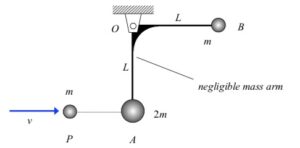| Problem statement Solution video |
DISCUSSION THREAD

Discussion and hints:

For this problem, make your system big. In your FBD include A, B, P and link AOB. With this choice, you can simplify your angular impulse-momentum analysis since you do not need to deal with the impact force between P and A since it will be internal to this system.
Step 1: FBDs
Draw an FBD of A, B, P and AOB together.
Step 2: Kinetics (angular impulse/momentum)
Consider the external forces acting on your system in your FBD. Which, if any, forces cause a moment about the fixed point O? Write down the angular momentum for each particle individually and add together to find the angular momentum for your system: HO = 2m rA/O x vA + m rB/O x vB + m rC/O x vC. Is this momentum conserved? Also, consider using the coefficient of restitution equation.
Step 3: Kinematics
Use the rigid body velocity equation to relate the velocities of A and B.
Step 4: Solve
Use your results from Steps 3 and 4 to solve for the angular speed of AOB.
Any questions?
On the free body diagram there would only need to be reaction forces drawn at O because otherwise there are no other forces acting external to the system. Is that it for the FBD?
The FBD will depend on what you have chosen as your system. If YOUR system includes A, B, P and the angled bar, then, yes, the only forces acting will be at the pin O. If you choose a different system, then the FBD will be different.
Again, the choice of system is YOUR choice.
When does the coefficient of restitution equation have a negative sign in front of it and when does it not? It seems like some examples use a negative sign in front while others do not need it.
The COR equation is ALWAYS given by:
e = -(vBn2 – vAn2)/(vBn1 – vAn1)
Could you point out examples where the negative sign is not present in the solution? We need to fix those examples.
The negative sign is always required in the coefficient of restitution equation.
It is also possible that some examples have the negative sign already distributed into the equation, making it e = (vAn2 – vBn2) / (vBn1 – vAn1) rather than e = -(vBn2 – vAn2)/(vBn1 – vAn1).
Do we assume that particle P moves with A after the collision?
No, it bounces back into the horizontal direction at some unknown velocity.
The only way that A and P move together after impact is if e = 0. It is NOT given that e = 0.
You can check your final answer by setting e = 0, and look at the resulting answers for vA and vP after impact – they should be equal.
Do we assume that the distance from O to P is -L in the j direction since it is right next to A before and after impact?
Yes, these are particles having small physical dimensions.
If possible should we cancel out mass from our final answer or leave it in.
If you can cancel it, then you should do so. The problem states ‘at most m, l, v, and e’. We don’t necessarily need all of them.